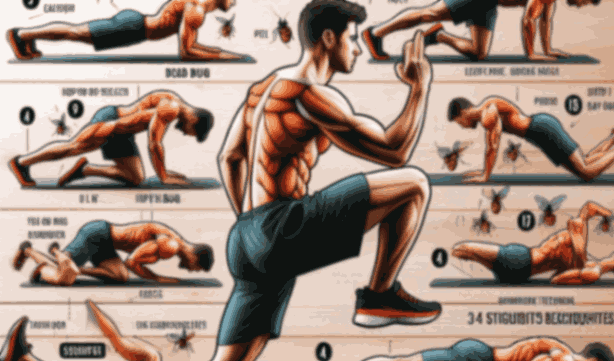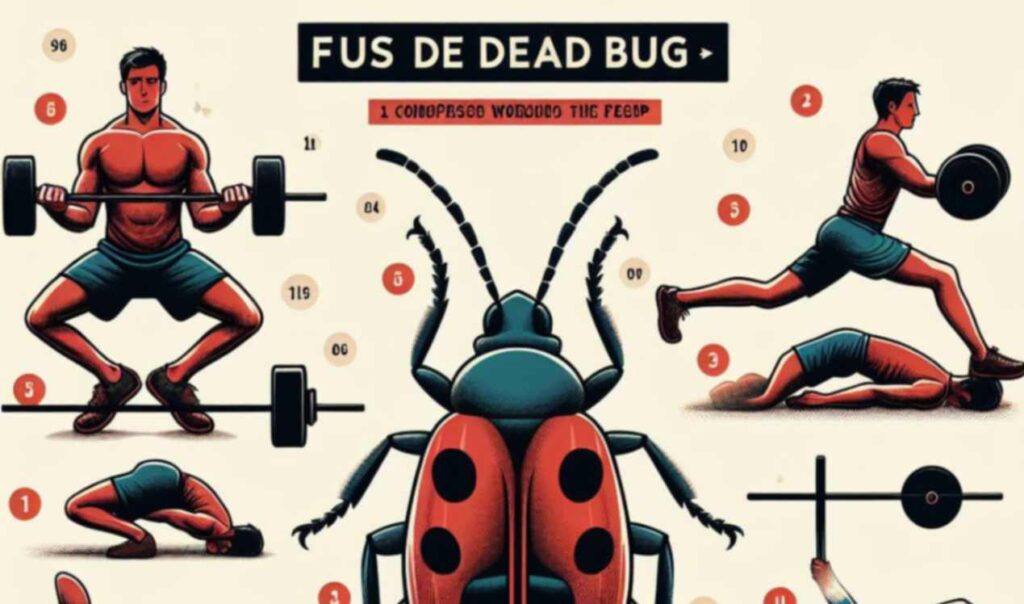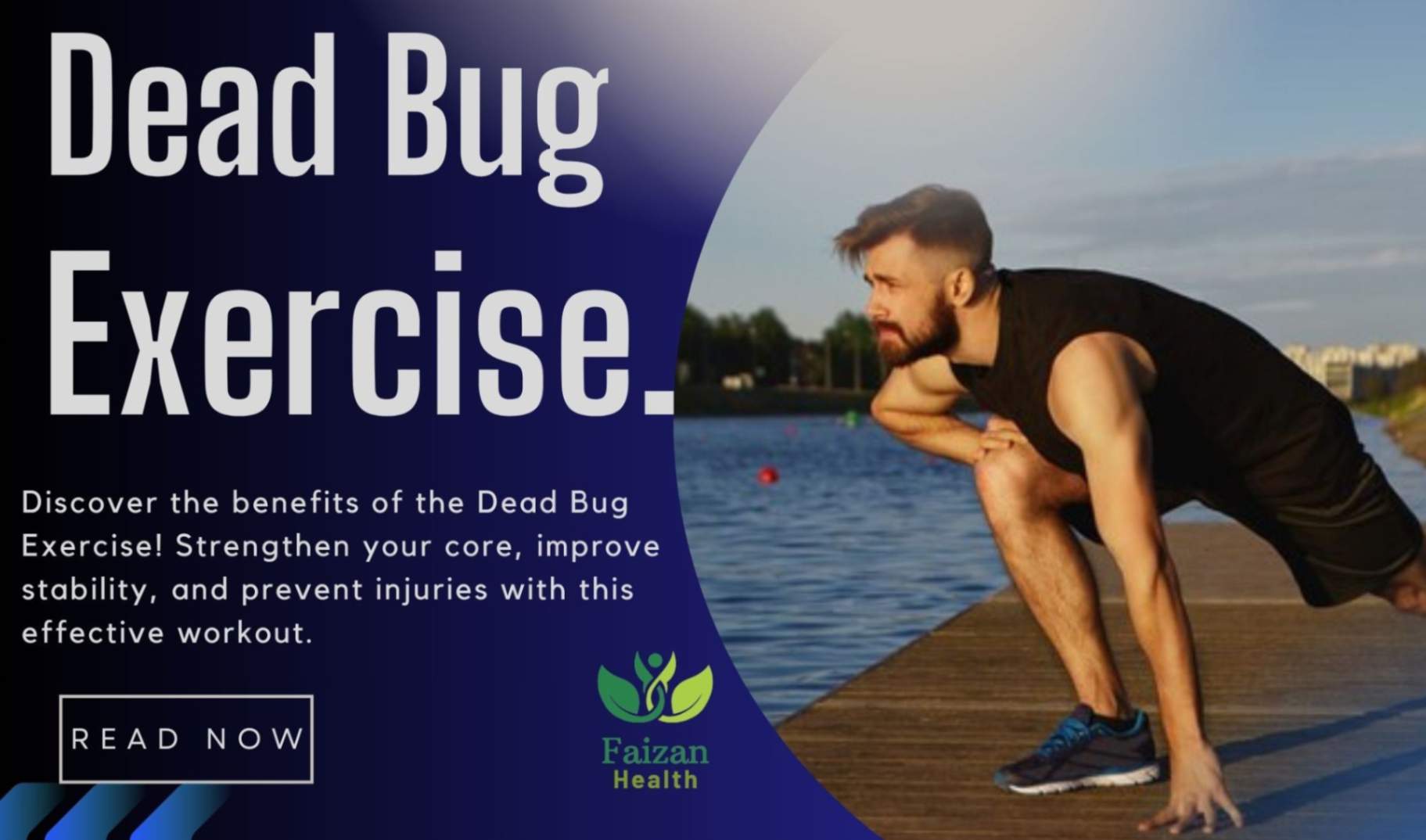The goal of the dead bug exercise is to strengthen the core and improve spinal stability using a basic yet very effective action. This exercise, which has its roots in physical therapy, has become more and more popular in fitness regimens due to its capacity to enhance general body control, avoid injuries, and improve posture. We’ll go over the methods, advantages, typical blunders, variants, and how to include the dead bug workout into your fitness routine in this article. Whatever your level of experience with exercise, knowing how to perform this exercise will greatly improve your fitness journey. Let’s investigate the dead bug exercise and discover how it can help you build a stronger, more flexible physique.
I. Benefits of Dead Bug Exercise:
With so many benefits, the dead bug workout is a terrific addition to any fitness program. A thorough description of each of the advantages is provided below.
A. Core Strength:
The main objective of dead-big exercises is to strengthen the core muscles, which comprise the rectus abdominis, transverse abdominis, obliques, and deep, stable muscles of the spine. The dead bug uses these muscles to support the spine during movement, effectively targeting and strengthening the core. This improves functional strength and stability in daily tasks as well as athletic performance.

B. Stability of the spine:
The capacity of deadlift exercises to enhance spinal stability is one of their primary advantages. The exercise encourages healthy spinal alignment and stability since it necessitates that the person maintain a neutral spine position during the activity. This can be especially helpful for people who are healing from spinal injuries or have weak core muscles because it can lower the risk of back discomfort and enhance general spine health.
C. Better Posture:
Engaging in regular deadlift workouts can enhance posture by fortifying the core muscles accountable for upholding appropriate spine and pelvic alignment. People may notice a reduction in shoulder slouching and rounding as their muscles get stronger and more engaged, which will result in a more straight and upright posture both during exercise and in daily life.
D. Injury Prevention:
Exercises including deadlifts can strengthen core muscles and improve spinal stability, which can help lessen the risk of injury, particularly to the back and lower back. By strengthening the body’s defense against outside pressures and preserving ideal alignment while moving, people can reduce their risk of sprains, strains, and other frequent injuries brought on by weak core strength and stability. declines.
II. Technique:
A. Starting Position:
Lie on your back: Begin by lying on your back on a cosy surface or an exercise mat.
Arms Raised to the Ceiling: While standing on the ground, raise your arms straight up towards the ceiling.
90-degree bent legs: Maintain your feet off the ground while bending your knees at a 90-degree angle. The floor should be parallel to your shin.

B. Implementation:
Engage Core Muscles: Pull your belly button towards your spine to contract your core muscles before beginning the exercise. It aids in pelvic and spine stability.
Lower opposite arm and leg simultaneously:
Keeping your core engaged, slowly lower your right arm toward the floor behind your head while extending your left leg straight out, hovering just above the ground. Keep the movement slow and controlled.
Maintain lower back stability:
Throughout the movement, focus on keeping your lower back pressed into the floor to prevent any arching or over arching of the spine. It helps engage the deep core muscles and protects your lower back.
C. Return to starting position:
Returning the arm and leg to the starting position:
Once the exercise has reached its conclusion and both of your arms and legs are completely extended, return them to the starting position at the same time, slowly.
Keep your composure during the entire movement:
Steer clear of abrupt or jerky motions. Rather, concentrate on preserving stability and control during the exercise to completely contract the targeted muscles and reduce the chance of damage.
D. Repetition and Sets:
Recommended repetition range:
Start with 8-10 repetitions per side, gradually increasing as you get stronger and more comfortable with the exercise.
Adjustments for Beginner, Intermediate, and Advanced Levels:
Beginners can start with low repetitions and focus on mastering technique before increasing intensity. Intermediate and advanced individuals can increase the number of repetitions or add variations to further challenge their core stability.
III. Common Error And Corrections:
A. Arching in the lower back:
Error: Encouraging the lower back to arch while performing the exercise.
The fix: Focus on flattening your back against the ground by contracting your abdominal muscles. During the exercise, Imagine pressing your lower back into the mat to maintain proper spinal position.

B. Allowing the hips to rotate:
Fault: Allowing the hips to rotate or tilt to one side during the movement.
The Correction: Keep your hips stable and square throughout the exercise. Engage your core muscles to prevent any unwanted movement in the hips. Imagine keeping your pelvis in a neutral position to maintain stability.
C. Lifting the shoulders off the floor:
Error: Raising the shoulders off the ground, leading to stress in the shoulders and neck.
Correction:
Throughout the exercise, maintain a relaxed posture and apply light pressure to the floor. Steer clear of stressing your neck muscles or hunching your shoulders. Make sure your upper body remains calm and your core remains active.
D. Not engaging core muscles:
Mistake: Not fully engaging the core muscles, leading to less effective activation of the targeted muscles.

The solution:
Make it a priority to use your core muscles right from the start of the activity. To engage the deep abdominal muscles, concentrate on drawing your belly button in the direction of your spine. Keep the core engaged throughout the movement for maximum effectiveness.
IV. Variations and Progressions:
A. Single Leg Dead Bug:
Execution:
Do the dead bug exercise while keeping one leg straight out instead of bending both legs at 90 degrees.
Benefits: Increases the challenge for core stability and improves balance and coordination.
Progression: Start with a few repetitions on each side and gradually increase as you build strength and control.
B. Straight Leg Dead Bug:
Hang: Keep both legs straight out, hovering slightly off the ground when doing the dead bug exercise.
Benefits: Stimulates core muscle engagement and challenges hip flexibility.
Progression: Start with a small range of motion and gradually work toward bringing the legs closer to the floor without arching the lower back excessively.
C. Weighted Dead Bug:
Execution: Hold a light dumbbell or medicine ball in each hand while doing the deadlift exercise.
Benefits: Adds resistance to the movement, increasing the challenge for core strength and stability.
Progression: Start with light weights and gradually increase the resistance as you get stronger and more proficient at the exercise.
D. Dead bug with stability ball:
Implementation: Hold a stability ball between your hands and knees while doing the dead bug exercise, adding an element of instability.

Benefits: Increases overall core strength and coordination, requiring more core activation to balance on a stability ball.
Progression: Start with a larger stability ball and progress to smaller sizes as you improve stability and control.
Conclusion:
There are many advantages to include deadlift exercises in your fitness regimen, such as increased spinal stability, higher core strength, and enhanced overall body control. People can mini mise the danger of injury and at mosthe efficiency of this exercise by learning common faults and good technique. In addition, experimenting with variants and progressions offers people of all fitness levels an ongoing challenge and opportunity for growth.

However, it’s important to approach deadlift exercises with caution, especially for those with pre-existing spinal conditions, pregnancy, or recovering from injuries. Consultation with health care professionals ensures exercise is safe and appropriate for individual circumstances. With dedication, consistency, and a focus on proper form, the dead bug workout can be a valuable addition to any fitness regimen, contributing to a stronger, more flexible body and overall wellness.
Read More About Neuron Activation.
Can a Dead Bug Exercise?
Yes, the majority of people, both novices and seasoned fitness lovers, can benefit from the dead bug workout. However, before exercising, people with pre-existing spinal issues, those who are pregnant, and people who are recuperating from recent injuries should speak with a healthcare provider.
How many repetitions should I do for the Dead Bug exercise?
Starting with 8–10 repetitions on each side is recommended, and as you get stronger and more accustomed to the workout, gradually increase the number. Alter the number of repetitions for each set based on your fitness level and goals while maintaining proper form and control.


Can you be more specific about the content of your article? After reading it, I still have some doubts. Hope you can help me.
Can you be more specific about the content of your article? After reading it, I still have some doubts. Hope you can help me. https://accounts.binance.com/en-ZA/register-person?ref=JHQQKNKN